Science Highlights, November 25, 2015
Awards and Recognition
Computer, Computational and Statistical Sciences
Impact of the loss of large mammalian herbivores on the global methane cycle
Materials Science and Technology
Uranium-niobium experiments validate models for aging degradation and material processing
Science on the Roadmap to MaRIE
Synchrotron 3-D imaging during uniaxial loading experiments sheds light on material damage
Awards and Recognition
Breakthrough Prize in Fundamental Physics recognizes neutrino research

Breakthrough Prize
More than 1,300 scientists, including 35 from Los Alamos, received the 2016 Breakthrough Prize in Fundamental Physics for their work in defining neutrino oscillations across five international experiments. The research led to the determination that neutrinos have mass. The experiments include: Sudbury Neutrino Observatory (SNO), Super-Kamiokande (Super-K), the KEK-to-Kamioka/Tokai-to-Kamioka (K2K/T2K), Kamioka Liquid-scintillator Antineutrino Detector (KamLAND), and Daya Bay Reactor Neutrino Experiment (Daya Bay). This award is based on the neutrino research for which Takaaki Kajita of Super-K and Arthur McDonald of SNO received a 2015 Nobel Prize in Physics. Unlike the Nobel Prize, which is awarded only to the experiment leaders, the Breakthrough Prize recognizes all team members.
Neutrinos are one of the most numerous particles in the entire universe, second only to particles of light. The three types of neutrinos are electron, muon, and tau. Neutrinos are difficult to study because they are neutral and rarely interact with other matter. Prior to these five experiments, scientists thought neutrinos were massless. SNO and Super-K proved that neutrinos change identity from electron neutrinos (the only type that the Sun produces) to muon or tau neutrinos as they reach Earth. The change in identity indicates that the neutrinos must have mass. Kamland, K2K/T2K, and Daya Bay further measured these oscillations in neutrinos and antineutrinos. Knowing that neutrinos have mass allows researchers to better understand how the universe formed the way it did.
During 20-plus years, more than 30 Los Alamos researchers participated in the SNO collaboration: developed and assembled the neutral current detector array that made an independent measurement of the total solar neutrino flux, delivered low-background photomultiplier tubes, created custom calibration sources and data acquisition software, and performed data analysis and simulations. Current Lab employees: Tom Bowles (Experimental Physical Sciences, ADEPS), Michael Browne (Safeguards Science and Technology, NEN-1), Steve Elliott (Neutron Science and Technology, P-23), Ernst Esch (Shock and Detonation Physics, M-9), Mac Fowler (Nuclear and Radiochemistry, C-NR), Kate Frame (Advanced Nuclear Technology, NEN-2), Keith Rielage (P-23), Laura Stonehill (Space Science and Applications, ISR-1), and Richard Van de Water (Subatomic Physics, P-25).
LANL researchers participated in other experiments. In the Super-K experiment, Christopher Mauger (P-25) had a significant role in the calibration and simulation of the detector, and Todd Haines (P-23) worked on Super-K’s veto system, calibrations, and analysis. Johnny Goett and Wenqin Xu (P-23) had roles on Daya Bay before they came to the Lab as postdocs several years ago.
Los Alamos has been involved in neutrino detection since the 1950s when Fred Reines and Clyde Cowan, Jr. led an effort that resulted in the first experimental proof that the elusive particle existed. Reines received the Nobel Prize in 1995 for this discovery. Technical contact: David Oro
Yu-Miin Sheu and Brad Ramshaw receive LANL Postdoctoral Publication Prize
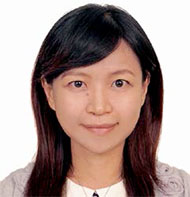
Yu-Miin Sheu
Yu-Miin Sheu (Center for Integrated Nanotechnologies, MPA-CINT) and Brad Ramshaw (Condensed Matter and Magnet Science, MPA-CMMS) have won Laboratory Postdoctoral Publication Prizes in Experimental Sciences. Damon Giovanielli and LANL sponsor the award to recognize the value and scientific contributions that postdocs make to the Laboratory. The Prize honors the best article in experimental sciences that has been published or accepted for publication. The publications reflect experimental research in the physical, chemical, or biological sciences performed primarily during the tenure of the postdoc’s appointment.
Yu-Miin Sheu won first place for her publication, “Using Ultrashort Optical Pulses to Couple Ferroelectric and Ferromagnetic Order in an Oxide Heterostructure,” Nature Communications 5, 5832 (2014). Magnetoelectric multiferroic materials possess both ferromagnetic and ferroelectric order. Sheu used femtosecond time-resolved second harmonic generation optical measurements to unravel magnetoelectric coupling in a ferroelectric/ ferromagnetic oxide heterostructure.
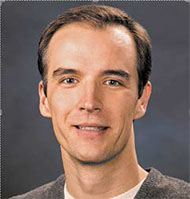
Brad Ramshaw
These first ultrafast optical measurements on the heterostructures reveal the intrinsic timescales that limit operating speed and demonstrate that ultrashort optical pulses can control the coupling between two different order parameters. The paper provides insight on the mechanisms underlying magnetoelectric coupling in complex oxide heterostructures and suggests the potential for future high-speed optically controlled magnetoelectric devices. Sheu is now an Assistant Professor in the Department of ElectroPhysics at Chiao Tung University, Taiwan.
Brad Ramshaw won second place for his publication, “Quasiparticle Mass Enhancement Approaching Optimal Doping in a high-Tc Superconductor”, Science 348, 317 (2015). The paper reports long-sought experimental evidence of the link between the quantum criticality and exotic high-temperature superconductivity. This result represents a major advance in the study of the high temperature superconducting cuprates, one of the central problems in condensed matter physics. The finding is a key milestone in the eventual understanding of the physics of high-temperature superconductivity. Ramshaw is the sole corresponding author of this paper. He became a Lab staff scientist at the National High Magnetic Field Lab in April 2015.
Damon Giovanielli, retired Division Leader of the Lab’s Physics Division and current President and Director of Sumner Associates Consulting Firm, sponsors the Publication Prize in Experimental Sciences. The Postdoctoral Program Office administers the award competition. Technical contact: Mary Anne With
Carl Gable co-authors National Academy of Sciences report
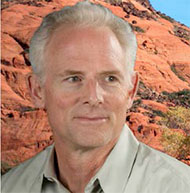
Carl Gable
Carl Gable, Group Leader of EES-16 (Computational Earth Science) served on a multi-disciplinary committee that co-authored the National Academies of Sciences, Engineering, and Medicine report Characterization, Modeling, Monitoring, and Remediation of Fractured Rock. The report examines the characterization of fractured rock and processes related to subsurface contaminant fate and transport. In the nearly 20 years has passed since the National Research Council publication Rock Fractures and Fluid Flow: Contemporary Understanding and Applications, the fundamental understanding of the physical nature of fractured rock has changed very little. However, new characterization tools have been developed, and there is a greater appreciation for the roles that chemical and biological processes play in fractured rock environment. The recent report reviews the last 20 years of developments, knowledge, and approaches to engineering at fractured rock sites.
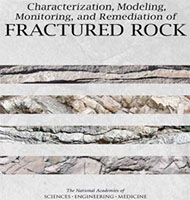
Fractured Rock
Bioscience
Tunable riboregulator switches for post-translational control of gene expression
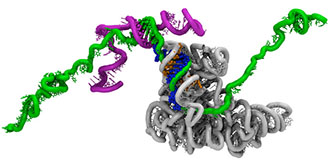
Figure 1. The switches control cellular metabolism with exquisite precision. The switches (pink) are made of RNA molecules and designed to control transmission of information (green/blue) to molecular machines (grey/orange) inside living cells.
Living cells have multiple mechanisms to control and regulate processes—many of which involve regulating the expression of genes. Scientists have investigated ways of synthetically altering gene expression for alternative purposes, such as biosynthesis of therapeutics or chemicals. A collaboration among Laboratory experimental and theoretical biologists produced a new method to control gene expression. The key is a tunable switch made from a small non-coding RNA molecule that could have potentially useful technical applications. The Los Alamos team discovered a new modular synthetic regulatory RNA (riboregulator) class that has the potential to finely tune protein expression and independently control the concentration of each enzyme in an engineered metabolic pathway. ACS Synthetic Biology published the research.
The team developed a synthetic biology approach in which riboregulators fine-tune gene expression with potential application to metabolic engineering (Figure 2). The investigators designed the overall architecture of the riboregulators using Watson−Crick base-pairing stability. Cis-repressor (crRNA) and trans-activator RNA (taRNA) compose the riboregulators. The cis-repressor can fold to a structure that sequesters the ribosomal binding sequence, preventing translation of the downstream gene. This action blocks expression of the gene. The taRNA undergoes independent transcription. The binding and subsequent structural transition between these two regulatory RNA elements dictates whether or not the transcribed mRNA will be translated into the protein product. For example, the scientists demonstrated a cis-repressor that completely shut off translation of antibiotic-resistance reporters and the trans-activator that restores translation. The level of translation can be tuned based on subtle changes in the primary sequence regulatory region of the taRNA, enabling translational control of gene expression over a wide dynamic range.
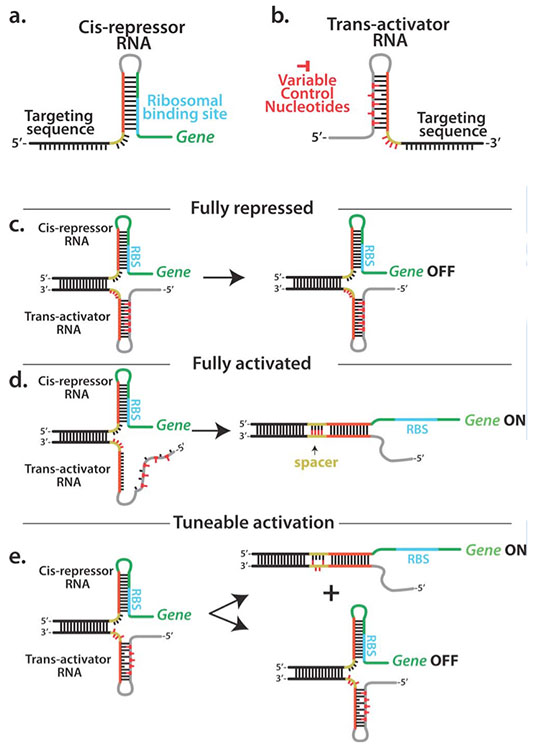
Figure 2. Schematic structure of the riboregulatory elements. (a) The modular design of the crRNA includes a targeting sequence (black) and a regulatory sequence (red) that forms a stem-loop structure at the 5′-end of the gene, sequestering the ribosomal binding sequence (RBS) and preventing translation of the messenger RNA (mRNA). (b) The taRNA is transcribed in trans and contains modules that are complementary to the targeting and variable regulatory sequences that produce stem-loop structures of differential stability. The all ON version of the taRNA has little potential to form secondary structures as depicted in (d). (c) The targeting sequence binding event forms a taRNA:crRNA/mRNA complex. In this complex, translation of the target gene is either repressed or (d) the complex rearranges to free the ribosomal finding sequence and activate translation. (e) It is possible to tune the relative stability of the secondary structural elements in the crRNA and taRNA to obtain intermediate levels of translation.
Reference: “Tunable Riboregulator Switches for Post-transcriptional Control of Gene Expression,” ACS Synthetic Biology, Article ASAP. doi: 10.1021/acssynbio.5b00041. Authors: Malathy Krishnamurthy, Taraka Dale, Shawn R. Starkenburg, Ricardo Martí-Arbona, David T. Fox, Scott N. Twary, and Clifford J. Unkefer (Bioenergy and Biome Sciences, B-11); Scott P. Hennelly and Karissa Y. Sanbonmatsu (Theoretical Biology and Biophysics, T-6).
The Laboratory Directed Research and Development (LDRD) program funded this work, which supports the Lab’s Global Security and Energy Security mission areas and Materials for the Future science pillar. Technical contacts: Clifford Unkefer and Karissa Sanbonmatsu
Chemistry
Harshini Mukundan co-edits book on mycobacterial diseases
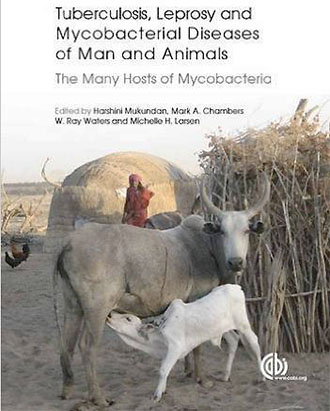
Figure 3. The book jacket from the monograph.
Harshini Mukundan (Physical Chemistry and Applied Spectroscopy, C-PCS) co-edited the monograph Tuberculosis, Leprosy and Mycobacterial Diseases of Man and Animals. These bacterial pathogens have caused a wide range of human and animal disease for millennia. Tuberculosis is probably the disease widest spread by a mycobacterial pathogen. It is responsible for nearly 1.5 million human deaths each year. The book describes research in the most important and widely researched groups of pathogenic mycobacteria: Mycobacterium tuberculosis complex, which causes tuberculosis, and Mycobacterium leprae, which causes leprosy.
These pathogens present many technical challenges for treatment. Mycobacterium tuberculosis exhibits increasing drug resistance especially in the context of co-infection with HIV. Moreover, possible cross-infection of Mycobacterial bovis from badgers and cattle provides a complicating factor in controlling mycobacterial infection in humans. This book offers a reference for researchers working in different fields on these diseases. It draws together information on different pathogens and considers the diseases in a zoonotic context to provide a “One Health” approach to these diseases. The approach recognizes that the health of humans, animals, and ecosystems are interconnected. One Health applies a coordinated, collaborative, multidisciplinary, and cross-sectoral approach to address potential or existing risks that originate at the animal-human-ecosystems interface. Comparing the research on mycobacteria in various animal species and models of infection minimizes redundancy and provides useful information to prevent further infection.
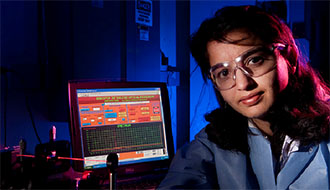
Photo. Harshini Mukundan with the optical biosensor that her team has been developing to detect tuberculosis and other diseases.
Mukundan has been researching tuberculosis and other diseases since joining the Laboratory in 2006. She has focused on techniques for the early diagnosis of active tuberculosis infection in humans and cattle using a waveguide-based optical biosensor and novel assay methods. Mukundan co-organized an international workshop on tuberculosis that took place in Santa Fe, New Mexico, in 2010. She has published extensively on tuberculosis and other infectious diseases.
Other editors of the book are Mark Chambers (Animal Health and Veterinary Laboratory Agencies, UK), Ray Waters (USDA), and Michelle Larsen (Albert Einstein College of Medicine). CABI (Centre for Agriculture and Bioscience International) published the book. The work supports the Lab’s Global Security mission area and the Science of Signatures science pillar through the detection of disease. Technical contact: Harshini Mukundan
Computer, Computational and Statistical Sciences
Impact of the loss of large mammalian herbivores on the global methane cycle
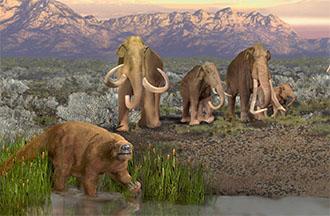
Figure 4. Artist’s depiction of the late Pleistocene landscape with some of the megaherbivores that became extinct. Credit: Karen Carr
Researchers have found that the massive loss of large herbivores during two historical events and the terminal Pleistocene extinction of megafauna have led to detectable changes in the atmospheric concentration of methane, a greenhouse gas. Examining the consequences of these earlier events yields insights into contemporary ecosystem function. Proceedings of the National Academy of Sciences published the work in the journal’s special feature on Megafauna in the Earth System.
Herbivorous mammals contribute methane to the atmosphere as a by-product of anaerobic digestion of plant material, with most of the gas released as burps. Although methane is approximately 200 times less abundant than carbon dioxide in the atmosphere, the greater efficiency of methane in trapping radiation and its reaction with other gases leads to a significant role in the radiative forcing of climate. Today, livestock are major contributors to the atmospheric methane budget, with as much as 85% of methane in countries such as New Zealand coming from this source. In the United States, about a third of anthropogenic methane output comes from livestock.
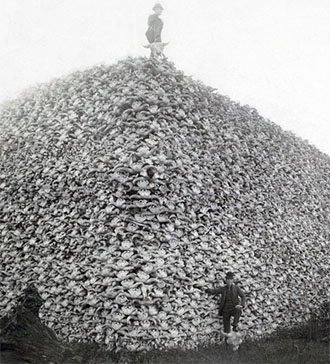
Photo. A massive pile of American bison skulls resulting from harvesting circa 1870.
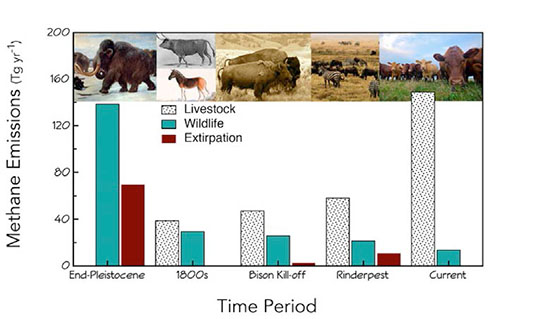
Figure 5. Enteric methane emissions by wild (teal) and domestic (spotted) herbivores. Red color indicates the reduction in methane emissions resulting from extinctions or extirpation of animals. The rinderpest epizootic epidemic affected both domestic and wild animal sectors. Emissions by domestic animals outpaced wild mammals just before 1800 AD.
The results give clues to the striking influence that large mammals can have on ecosystems and global processes such as climate. The methane record is not resolved finely enough to examine historical events directly. However, ice cores indicated an abrupt drop in methane concentrations immediately following the megafauna extinction in the late Pleistocene, and the isotope signature of methane transitioned abruptly from one largely produced by mammals to a system dominated by boreal and tropical wetlands. The team used a simple atmospheric model to estimate that the late Pleistocene megafauna extinction and associated surface albedo alterations from mammoth-mediated vegetation changes may have led to a global temperature decrease by as much as 0.5° C. The authors suggest that the integrated effects of the late Pleistocene extinction approximate the magnitude of anthropogenic climate change over the last century.
The authors’ quantitative approach yields unique insights into the role of wild mammals on global biogeochemical cycles over the historic and ancient past and contemporary ecosystem function. The findings demonstrate that wild mammals are a significant source pool of enteric emissions and should be included in the Intergovernmental Panel on Climate Change (IPCC) inventories. The methane emissions are just one aspect of the megaherbivores’ influence on biogeochemical cycling. In the absence of heavy grazing by animals, water tables can rise, leading to a slowdown in the rate of nutrient breakdown and recycling, an increase in organic matter accumulation, and a decrease in soil fertility. Selective foraging can also lead to shifts in vegetation structure and composition, which in turn can influence the albedo of the landscape and result in changing heat absorption and reflectivity. The findings underscore the importance of large mammals in regulating ecosystems and feedbacks on climate.
The authors also conclude that humans have been influencing biogeochemical cycling longer and in more complicated ways than previously thought. For example, outbreaks of rinderpest have
followed invading armies throughout much of human history. Thus, the long-term cumulative impact of rinderpest may be considerable. Their research shows that the mass removal of millions of mammals can have consequences on global processes and that the specific impacts are dependent on the physiology and ecology of those organisms.
Reference: “Exploring the Influence of Ancient and Historic Megaherbivore Extirpations on the Global Methane Budget,” Proceedings of the National Academy of Sciences, published online ahead of print (2015); doi: 10.1073/pnas.1502547112. Authors: Felisa A. Smith, John I. Hammond, Meghan A. Balk, Melissa I. Pardi, Catalina P. Tomé, and Marie L. Westover (University of New Mexico); Scott M. Elliott (Computational Physics and Methods, CCS-2), S. Kathleen Lyons and Peter J. Wagner (Smithsonian Institution).
The research supports the Lab’s Global Security mission area and the Science of Signatures science pillar through the study of the impact of animal populations on a greenhouse gas and the potential resulting climate change. Technical contact: Scott Elliott
Materials Physics and Applications
Fuel cell team receives DOE funding for R&D project
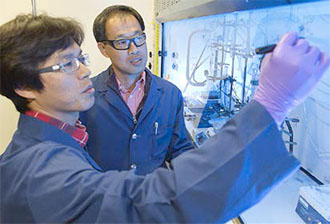
Photo. (Left): Kwan-Soo Lee and Yu Seung Kim (right) conduct experiments.
In 2013, Kwan-Soo Lee (Chemical Diagnostics and Engineering, C-CDE), Yu Seung Kim (Materials Synthesis and Integrated Devices, MPA-11), and their collaborators designed new anion exchange polymers, tested them in alkaline membrane water electrolysis, and demonstrated their record-high durability. The results led the sponsor of this work, DOE’s Fuel Cell Technologies Office, to distinguish Los Alamos as having a core capability in alkaline membranes. With $3 million in new funding from the DOE’s Fuel Cell Technologies in the Office of Energy Efficiency and Renewable Energy, a Laboratory scientific team will strive to overcome key challenges in developing alkaline anion exchange membranes for fuel cell applications over the next three years.
Yu Seung Kim will lead this new project titled, “Advanced Materials for Fully Integrated Membrane Electrode Assemblies in AEMFC (Anion Exchange Membrane Fuel Cells).” LANL will partner with experts in hydrocarbon anion exchange membranes (Sandia National Laboratories and Rensselaer Polytechnic Institute), leaders in hydrogen oxidation reaction catalysts (Argonne National Laboratory), and an industrial membrane authority (Giner Inc). By combining these efforts with the Lab’s longstanding expertise, the Los Alamos team intends to bring the anion exchange membrane fuel cell to commercial reality.
The thin material in alkaline anion exchange membranes poses a technical challenge because it disintegrates under high pH conditions. If stable alkaline membranes are developed, automakers could replace expensive platinum catalysts with nonprecious-metal catalysts. Such materials also could revolutionize other energy applications such as redox flow cells, air-metal batteries, and membrane-based water electrolysis.
The work supports the Lab’s Energy Security mission area and Materials for the Future science pillar through the development of materials for energy applications. Technical contact: Yu Seung Kim
Materials Science and Technology
Uranium-niobium experiments validate models for aging degradation and material processing
A decade-long experimental campaign to understand and predict thermal aging of uranium-niobium (U-Nb) alloys at Los Alamos has provided unique data validating innovative thermodynamic and kinetics modeling. These alloys behave similarly to stainless steel, with good corrosion resistance and ductility in the initial condition. However, the U-Nb alloys suffer from severely degraded properties after thermal exposures. The phase transformations responsible for aging are quite complicated even though the alloy contains only two major elements. The significant body of experimental data gained at Los Alamos and elsewhere makes this material a good test case for critical comparisons of the theory of solid-state phase transformations with experiment. The insights gained will improve models of processing and aging of U-Nb and a wider variety of alloys. Proceedings of the International Conference on Solid-Solid Phase Transformations in Inorganic Materials 2015 published the work.
Researchers encapsulated several hundred U-Nb alloy specimens in quartz and aged them under controlled conditions ranging from 100 to 625 oC in the Sigma facility at LANL. Sampling the entire phase transformations pathway from initial time to equilibrium required very long-term aging, up to 5 years. The team characterized the microstructure via light and electron microscopy, and measured the phase amounts and compositions by x-ray diffraction.
A companion multi-scale modeling effort had two major aims: 1) update the thermodynamics and diffusion models for U-Nb, which undergird simulations of engineering-relevant thermal treatments for both initial manufacture and in-service aging; and 2) gain fundamental scientific insight into the complex kinetics paths traversed by the system from initial time to equilibrium.
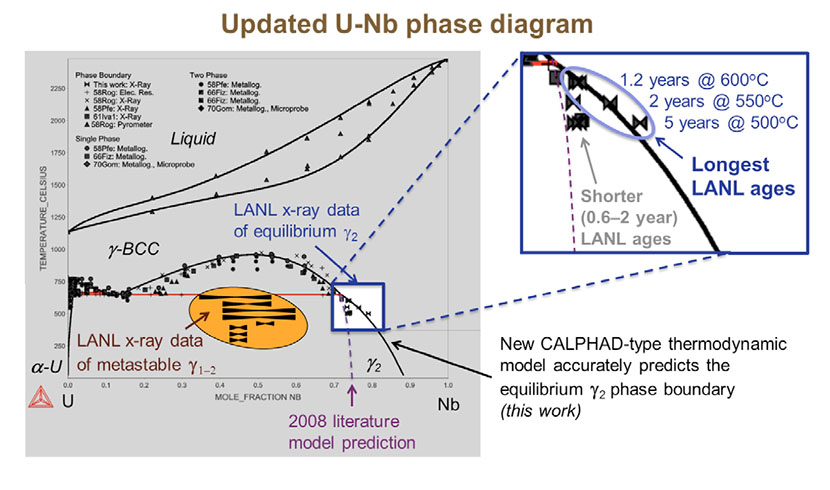
Figure 6. Updated uranium-niobium phase diagram.
Figure 6 shows the updated equilibrium phase diagram. The team evaluated the new model using the CALPHAD (CALculation of PHAse Diagrams) framework, which ensures an optimal fit accounting for both phase equilibria data (black data points) and thermochemical data (not shown). For the first time in this system, the researchers incorporated first-principles calculations of density functional theory into the overall assessment. The long-term LANL aging data (inset) validated a key prediction of the model, the g2 phase boundary on the niobium-rich side.
The team performed phase field simulations of microstructural evolution of the a (orthorhombic) and g (body-centered cubic, bcc) phases and their compositions to better understand the complicated kinetic paths that lead to final equilibrium at temperatures between ambient and 647 oC. As early as 1972, experiments had revealed that the system paused at a metastable phase, g1-2, of intermediate composition, approximately 50 atomic % Nb. The new study has amplified this puzzling result, shown in the orange region in the phase diagram figure. Because these compositions fall within the unstable region of the phase diagram (g-bcc miscibility gap), researchers need a new approach to explain the observation of a persistent metastable g1-2 phase and the total phase transformation sequence. The team conducted phase field kinetics modeling, employing as inputs the same thermodynamic model used to predict the phase diagram (Figure 6), in addition to a variety of diffusion parameters also modeled in this study.
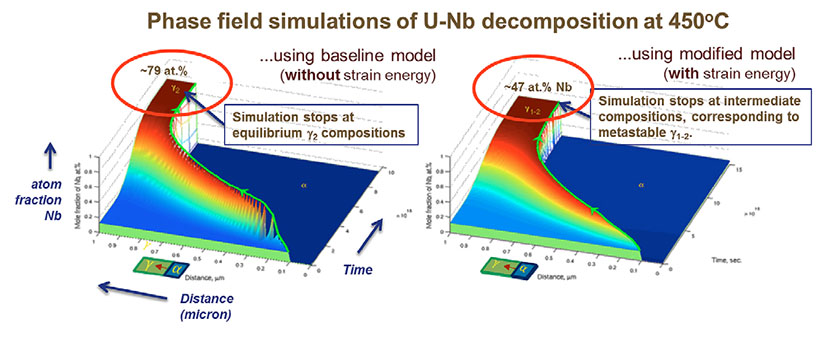
Figure 7. Phase-field kinetics simulations of a U-Nb diffusion couple at 450 oC without (left) and with (right) the use of strain adjusted free energies in the simulation code. The vertical axis and color indicates the composition, and by extension the phase (blue has ~0 at.% Nb and is -U; turquoise, yellow, and red are richer in Nb and represent the -bcc phase.)
Figure 7 depicts phase-field kinetics simulations of a U-Nb diffusion couple at 450 oC without (left) and with (right) the use of strain adjusted free energies in the simulation code. As time increases (moving front to back), the alpha phase grows at the expense of the gamma phase, and the gamma increases its niobium content to conserve mass. How much the gamma composition changed was the major question. The results using the baseline thermodynamic model by itself (left side) failed to predict the g1-2 phase, and instead evolved the system straight to the equilibrium g2 phase. To explain the persistence of the g1-2 phase, the authors hypothesized that strain energy between the misfitting a and g crystal structures would shift Gibbs free energy of the g-bcc phase in ways that would stabilize of the g1-2 phase. These modifications to the CALPHAD model (right) enabled improved phase-field predictions consistent with the experimental evidence. The team concluded that this is a plausible approach, which could be applied to other actinide alloys and other engineering alloys.
Reference: “A Hierarchical Computational Thermodynamic and Kinetic Approach to Discontinuous Precipitation in the U-Nb System,” Proceedings of the International Conference on Solid-Solid Phase Transformations in Inorganic Materials 2015. Los Alamos authors: Robert Hackenberg (Metallurgy, MST-6), Heather Volz (Weapons Test Engineering, W-14), Anna Llobet (Neutron Science and Technology, P-23), Alice Smith (Nuclear Materials Science, MST-16), and Graham King (Materials Science in Radiation and Dynamics Extremes, MST-8), with collaborators from Texas A&M University (Thien Duong, Raymundo Arroyave, and Sean Gibbons), Lawrence Livermore National Laboratory (Alex Landa and Patrice Turchi), California Institute of Technology (Saurabh Bajaj), and the Royal Institute of Technology in Sweden (Andrei Ruban and Levente Vitos). Tim Tucker, Pallas Papin, Bob Forsyth, Ann Kelly, Tim Beard, Jason Cooley, and Kester Clarke (MST-6) contributed to the specimen preparation, aging, and characterization at Los Alamos. The modeling portion of this work formed the PhD dissertation of Thien Duong at Texas A&M University; Hackenberg and Turchi served as external examiners.
The experimental portion of the work was performed at Los Alamos and funded through the NNSA Enhanced Surveillance Campaign (Tom Zocco, LANL Program Manager). The research supports the Laboratory’s Nuclear Deterrence and Energy Security mission areas, and the Materials for the Future science pillar by understanding and predicting the effects of material processing, aging, and corrosion on the properties, performance, and functionality of the materials. A synergy of unique actinide R&D experiments coupled with multi-scale modeling enabled the work. Technical contact: Robert Hackenberg
Science on the Roadmap to MaRIE
Synchrotron 3-D imaging during uniaxial loading experiments sheds light on material damage
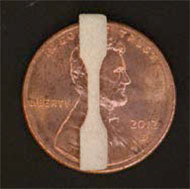
Photo. A laser sintered 3-D printed tensile specimen. Specimen is 2-cm in length. The black box indicates the field of view imaged at the synchrotron.
Three-dimensional (3-D) printed materials offer a wealth of potential applications because unique structures may be printed with geometries that are not possible with traditional molding, extrusion, casting, or machining techniques. Structures may be optimized for weight, strength, or form, to improve their overall function.
However, there are some technical challenges resulting from the method of creating the materials. The 3-D printed structures are created through the serial laydown of materials, layer-by-layer. Inherent discontinuities within the microstructure reduce the overall mechanical strength of a part when compared with traditionally formed materials. Interfacial adhesion through polymer chain entanglement is minimized. Mechanical testing indicates that print orientation as well as the use of print material recycling can affect the ultimate mechanical performance. Due to these problems, there are very few demonstrated high performance applications of 3-D printed materials, especially polymers. In situ analysis techniques are needed to understand the adhesion between the layers and crack initiation, propagation, and ultimately failure. The typical hyper-elastic nature of the materials presents an additional challenge. Experiments cannot be paused during data collection because the material will continue to deform and respond to the applied stress.
To address these challenges, LANL researchers led collaborative experiments with Arizona State University and Argonne National Laboratory’s Advanced Photon Source. The team collected 3-D tomographic data during uniaxial loading of 3-D printed tensile specimens. High speed, continuous 3-D tomography imaged the samples in 3-D during loading. In the fastest continuous 3-D imaging yet demonstrated, the investigators gathered four full 3-D images within one second as a loading rig was rotated at 2 Hz while applying a uniaxial load on 3-D printed materials. The investigators collected 18,000 radiographs during this dynamic event for reconstruction into approximately 20 tomograms. The researchers continuously loaded 3-D printed glass bead loaded nylon polymers to failure while collecting 901 radiographs for every 180o of rotation and simultaneously recording strain. This method imaged dynamic stretching, cracking, failure, and elastic recovery in these hyper-elastic materials.
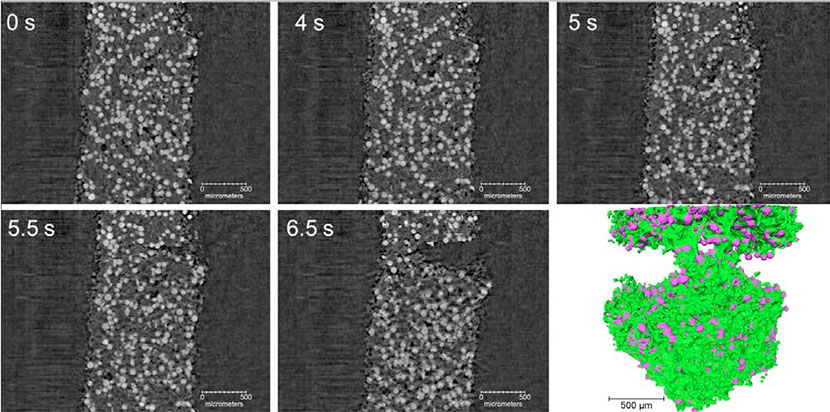
Figure 8. (Panels 0 – 6.5 s): A subset of the sequential reconstructed slices through the glass bead filled 3-D printed nylon polymer. The 3-D images were collected every 0.25 seconds. The material was under uniaxial tension from the bottom. Imaging continued through material breakage. Delamination between the polymer and the beads are clearly seen. The beads appear “fuzzy” in the 3-D image at 6.5 s due to rapid sample motion. (Bottom right panel): False color 3-D rendering of the material during breakage. The glass beads are pink, and the polymers are green.
The team printed micro-specimens of glass bead filled polyamide sintered powder using a 30 W CO2 laser to build up the objects layer by layer. The researchers printed specimens in each of the three orthogonal orientations. They heated the entire powder bed to just below the melting temperature of the polymer during printing. The printed objects were removed from the powder, leaving behind powder that can be used by the next print. However, the material now has a thermal history. The tested and imaged specimens were printed with virgin material, 50% virgin-50% recycled, and 50%
virgin-50% doubly recycled material to understand the effect of the thermal history during recycling upon layer adhesion and mechanical performance. Figure 8 illustrates a subset of the sequential reconstructed slices through a specimen. The images reveal the delamination of the glass microbeads from the nylon, elongation of the nylon, breakage, and the elastic recovery. Some blurring of the image occurs at 6.5 seconds due to the high rate of the elastic recovery. The stress-strain curve of the material indicates a tensile strength of 50 MPa. This value is identical to both the manufacturer’s advertised strength of the material and the Lab’s full-scale mechanical test results. The material does not have a size effect for its mechanical strength. Full 3-D renderings of the materials reveal the movement of the glass particles. The bottom right panel shows a single volume rendering during elongation of the specimen.
The team plans to apply digital volume correlation to understand the flow of material during elongation, as well as faster imaging rates. Imaging techniques using a machine spindle to rotate the load cell with rates of 50 Hz (100 tomograms per second) are available. This work addresses the future mission of MaRIE (Matter-Radiation Interactions in Extremes), LANL’s proposed experimental facility for time-dependent materials science at the mesoscale, because it advances the tools needed to develop and manufacture next-generation materials for reduced-cost stockpile options through the use of additive manufacturing.
The multi-institutional team includes: Brian M. Patterson, Nikolaus Cordes, Kevin Henderson, James Mertens, and Robin Pacheco (MST-7); Nikhilesh Chawla and Jason Williams (Arizona State University); and Xianghui Xiao (Argonne National Laboratory).
The NNSA Enhanced Surveillance (Tom Zocco, LANL Program Manager) and Engineering (Eric Mas, LANL Program Manager) campaigns funded the Los Alamos work, which supports the Lab’s Nuclear Deterrence mission area and the Materials of the Future science pillar through the development of additive manufacturing. Technical contact: Brian M. Patterson
Theoretical
Behavior of amorphous materials under high strain
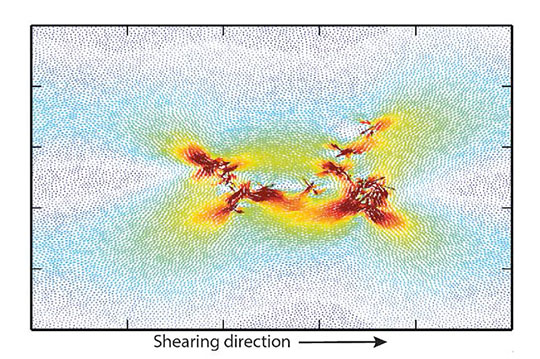
Figure 9. A picture of a reversible avalanche in the subcritical limit in an amorphous solid containing N = 16,384 particles under a periodic shear, where the darker regions indicate where particles have been displaced more. Despite the large scale of the avalanche, the motion is exactly repeated during the next drive cycle. Above a critical strain, the avalanches no longer repeat.
Disordered solids such as plastics, window glass and amorphous metals are an important and ubiquitous form of matter with many useful applications. Industrial processing of these materials commonly involves plastic deformation. The physical processes controlling the onset of yield, where a material changes its shape permanently under external deformation, are not yet understood for amorphous solids. The problem is key to understanding how a solid can fail. In findings published in Nature Communications, a research team from Los Alamos National Laboratory, Harvard University, and the University of Illinois-Urbana Champaign have found strong evidence that the point at which a disordered or amorphous solid begins to yield and flow under an applied stress exhibits features similar to those found in the study of chaos, as well as well as the transition accompanying a change of phase from one state of matter to another.
The transition from jammed to flowing behavior in systems as diverse as earthquakes, charge density waves, and disordered magnets is accompanied by the occurrence of avalanches of increasing sizes obeying power-law statistics, a signature of critical behavior. The new publication shows that in amorphous solids, at the same critical strain amplitude where irreversibility occurs, the system undergoes a non-equilibrium phase transition involving avalanches of diverging sizes.
The LANL team performed large-scale molecular dynamics and mean-field theory simulations of systems of 1,024, 4,096 and 16,384 point particles in two dimensions interacting. The researchers found that under periodic shearing, atoms rearrange themselves in avalanches or sudden bursts of activity (Figure 9). Below a critical strain, the system organizes to a state where the avalanches are exactly repeated and the atoms return to their previous positions at the end of each cycle. As the strain increases, there is a critical strain above which the avalanches do not exactly repeat and the atoms no longer return to the same positions at the end of the cycle. The authors had already established that the transition point is accompanied by cycles of ever increasing periodicity during which particles change their mechanical equilibrium positions but follow the same trajectories for consecutive cycles. Above a critical strain amplitude, the system does not settle into a limit cycle. The motion transitions to chaotic behavior, very reminiscent of systems undergoing nonlinear dynamics with initial close-by positions diverging exponentially with time and losing all memory of the initial state. This transition point, coinciding with a divergence in the time scale, has a behavior consistent with what is called criticality, which occurs for certain phase transitions where specific quantities at the transition can have universal features independent of the details or nature of the system. The result implies that the system out of equilibrium undergoes a nonequilibrium phase transition where energy is being pumped into it and dissipated. This phenomenon offers a new way to define the yield point in an amorphous solid. If these ideas extend to a broader class of systems, it would allow researchers to produce new predictive tools to examine the fluctuations or avalanches in a system to determine whether it is close to some kind of critical transition or failure, giving us time to prepare for or mitigate the failure process.
Reference: “Reversibility and Critically in Amorphous Solids,” Nature Communications 6, 8805 (2015); doi: 0.1038/ncomms9805. Authors: Ido Regev, Charles Reichhardt, and Turab Lookman (Physics of Condensed Matter and Complex Systems, T-4 and Center for Nonlinear Studies, CNLS); John Weber and Karin A. Dahmen (University of Illinois at Urbana Champaign). Regev is now a postdoc at Harvard University.
The NNSA Advanced Simulation and Computing Program/Physics and Engineering Models (ASC/PEM) program and the Lab’s Center for Nonlinear Science [sponsored by the Laboratory Directed Research and Development (LDRD) program] funded different aspects of the research, and Los Alamos provided Institutional Computing resources. The work supports the Lab’s Nuclear Deterrence and Energy Security mission areas and the Information, Science, and Technology and Materials for the Future science pillars. Technical contact: Turab Lookman





